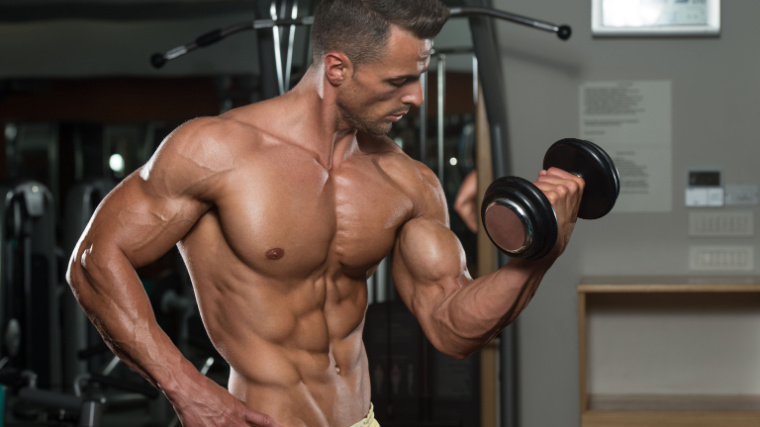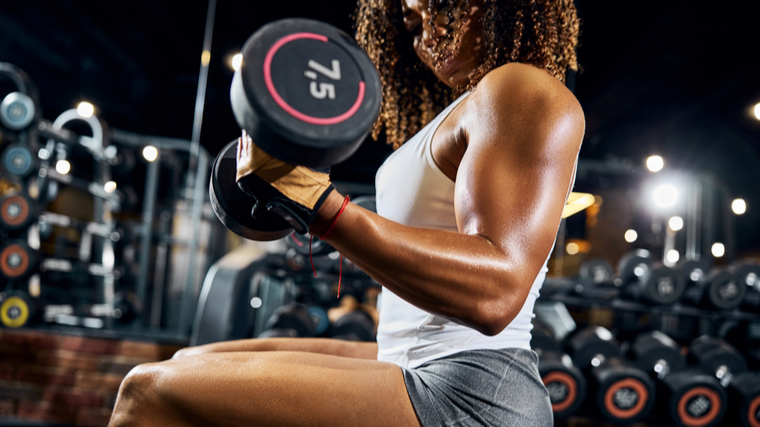If you’re an amateur or competitive bodybuilder, you’re probably concerned with more than just the size of your muscles. Mass is all well and good, but raw material is only half the equation — you need to present it properly to win big on the bodybuilding stage.
Think of Arnold Schwarzenegger’s famous pecs; he had a big chest, sure, but Schwarzenegger’s chest was also impeccably well-shaped (it’s how he came to be called the Austrian Oak). The same holds true for Tom Platz and his out-of-this-world wheels. Chris Bumstead presides over the Classic Physique division at the Mr. Olympia in no small part due to the shape and tightness of his abdominals.
https://www.instagram.com/p/BdIF7HZBA8H/
[Related: Bodybuilder Nick Walker Reveals His Prep Diet for 2023 Arnold Classic]
But what of the biceps? Bodybuilders revere the “peak” — biceps that, when flexed, seem to literally pop off the arm — something Schwarzenegger was famous for as well.
If muscular shape is just as important as size, it begs the question: Can you hit the weights hard and build a biceps peak of your own? In short; maybe. Here’s what the science supports (and debunks) about targeted arm growth so you can stack your arms to the ceiling.
Anatomy of the Biceps
You probably know how to find your biceps. They’re the quintessential mirror muscle, after all. Located on the front of your upper arm bone, your biceps brachii is a two-headed tissue that runs from your scapula (that’s your shoulder blade) over your elbow joint and down onto your forearm.
Every time you bang out a set of dumbbell curls, perform a pull-up, or even lower a bench press to your chest, your biceps are hard at work either as the prime movers or secondary stabilizers.
The Long Head and the Biceps Peak
The “two-headed” part of biceps anatomy is crucial when it comes to determining whether or not you can build a peak. Both heads of the biceps originate on the shoulder blade, albeit in different locations. As such, each head can perform slightly different anatomical duties relating to shoulder position. (1)
The long head of the biceps sits on the outside of the arm and gives the biceps their peak when flexed. Consequently, some coaches and athletes believe that manipulating shoulder position to bias the long head of the biceps during arm exercises will result in a more pronounced peak.

This is where things get sticky. That idea is backed by legitimate data — when you flex your biceps, the long head does show up at the “top.” (2) What’s more, some studies have shown that “joint position,” meaning the actual angle of your shoulder relative to your torso, might play a significant role in biceps activation at the long head:
“… increasing the length of the Biceps Brachii promoted increased activation of the long head in relation to the short head in producing rapid supination motions.” (3)
However, this isn’t an open-and-shut case. Preferential activation (meaning, actively trying to make one part of a muscle contract over another) is a contentious topic in the scientific community.
Some studies demonstrate that you can target specific heads of a muscle by altering joint position, (4)(5) while other data indicates that doing so doesn’t guarantee more engagement with the long head of the tissue, and thus, a bigger biceps peak. (6)
What the Science Says
The jury is still out about whether or not you can build a bigger biceps peak just by adjusting how you perform your curls, at least in a laboratory setting. The evidence seems to support the idea in principle, but not in price: Tweaking your training may theoretically make some level of difference, but whether or not you’d even notice the difference is unclear and hasn’t been credibly studied.
There’s also the lingering specter of genetics to consider. How your muscle bellies — their physical shape — look depends a great deal on insertion points, especially when you flex them.

Short-inserting biceps will naturally peak more than long ones. You can measure this for yourself by looking at how much of a gap exists between your forearm and where your biceps begins when you flex it. This aspect of how your arms look is, unfortunately, out of your control.
Best Exercises for Building a Biceps Peak
So, what can you do if you want biceps that stretch to the skies? Your best bet is to make some well-thought-out exercise selections and hammer them hard.
Based on the existing body of evidence, to target the long head of your biceps, you should perform curls that place your shoulder in hyperextension. Which is to say, with your arms behind your torso. Here are some of your options:
Incline Dumbbell Curl
The incline dumbbell curl does just about everything you could want out of an arm isolation exercise. It’s easy to perform, you don’t need a lot of equipment, and it absolutely crushes your biceps.
As long as you can find an angle on an adjustable bench that works for you, this movement should torch the long head of your biceps. Just make sure you keep your upper arm pinned back the entire time.
Drag Curl
It may look like an incorrectly-performed barbell curl, but don’t get it twisted — the drag curl is a legitimate exercise and also happens to be one of the only ways to target the long head of the biceps with a barbell.
The idea here is simple; perform a standard standing barbell curl, but instead of keeping your upper arm pressed against your torso, you should intentionally pull your elbows back to “drag” the bar up your body.
Bayesian Cable Curl
You’ve probably seen this exercise in your gym before, even if you don’t know what it’s called. The Bayesian cable curl is a seriously underrated biceps-builder, and it’s a movement that fully exploits the potential of the cable tree.
The exercise is essentially a single-arm cable curl. By facing away from the cable station itself and allowing your arm to drift behind your body, you fully lengthen the long head of your biceps. More stretch means more mechanical tension, which should confer more growth.
Sample Biceps Peak Workout
If you’re a beginner, you probably shouldn’t spend too much time focusing on one specific aspect of one muscle. Generalized arm training will work just fine in your first few years.
Beyond that, though, it’s perfectly acceptable to choose specific movements that may help you address lagging body parts. A biceps workout meant to build up your peaks may look something like this:
- Standing Barbell or Dumbbell Curl: 3 x 6
- Incline Dumbbell Curl: 3 x 8-10
- Bayesian Cable Curl: 2 x 12-15
As always, the rules of hypertrophy-focused training apply: Select weights that are challenging but doable with good form, leave one or two reps in the tank on a set-by-set basis, and focus hard on contracting the muscle in question.
Your Takeaways
When it comes to physique development, a muscle’s shape and proportion are just as relevant as how big you can make it. Whether or not you can meaningfully grow your biceps’ peaks is up for debate.
- Your biceps attach from your forearm to your shoulder blade. Changing the position of your shoulder may help grow the long head of the biceps, which contributes to the peak.
- Some literature shows that you can target specific areas of a single muscle for growth, but these results are contradicted by other data.
- Exercises like drag curls and incline curls, where your upper arm is behind your torso, may help bring up your biceps peaks a little bit. Some portion of how your biceps look when flexed is entirely genetic and thus can’t be changed by training.
There’s more evidence in favor of the possibility of growing your biceps peak than against it, but most data is correlative or circumstantial. Your results may vary — significantly.
The Pinnacle of Gains
If you want an impressive pair of arms, your best bet is to buckle down and train them hard for, well, years. It’s perfectly normal to want your physique to look a certain way. However, it’s also essential that you not lose sight of what factors are within your locus of control, and which ones aren’t worth stressing over.
You may be able to bring up your biceps peaks if you really pound away at a select few exercises, but the science behind this idea is far from conclusive. Still, there’s no harm in it. At worst, you’ll beef up your arms overall — a win in every way.
References
- Karunaharamoorthy, A. (2022, December 27). Biceps brachii muscle. Kenhub.
- Jarrett, C. D., Weir, D. M., Stuffmann, E. S., Jain, S., Miller, M. C., & Schmidt, C. C. (2012). Anatomic and biomechanical analysis of the short and long head components of the distal biceps tendon. Journal of shoulder and elbow surgery, 21(7), 942–948.
- Brown, J. M., Solomon, C., & Paton, M. (1993). Further evidence of functional differentiation within biceps brachii. Electromyography and clinical neurophysiology, 33(5), 301–309.
- Stoutenberg, M., Pluchino, A. P., Ma, F., Hoctor, J. E., & Signorile, J. F. (2005). The impact of foot position on electromyographical activity of the superficial quadriceps muscles during leg extension. Journal of strength and conditioning research, 19(4), 931–938.
- Signorile, J. F., Lew, K. M., Stoutenberg, M., Pluchino, A., Lewis, J. E., & Gao, J. (2014). Range of motion and leg rotation affect electromyography activation levels of the superficial quadriceps muscles during leg extension. Journal of strength and conditioning research, 28(9), 2536–2545.
- Furlani J. (1976). Electromyographic study of the m. biceps brachii in movements at the glenohumeral joint. Acta anatomica, 96(2), 270–284.
Featured Image: Jasminko Ibrakovic / Shutterstock